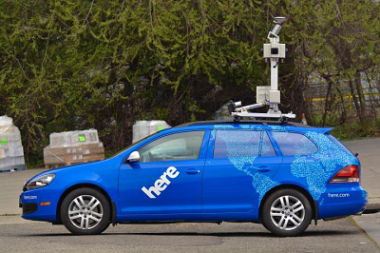Will Nokia’s HERE Map the Future of Driverless Cars?
Stephen Feyer
Will the autonomous car require detailed maps in order to drive itself on public roads? Nokia is betting that the answer will be yes.
Nokia, a Finnish company, is best known for the mobile handset business it no longer owns. Once the biggest name in mobile telephones, Nokia (NOK) in 2013 sold its handset business to Microsoft in a deal valued at more than 5.4 billion euros.
The company today has three divisions: technology licensing, mobile network technology, and its mapping division, Nokia HERE, which originated in Nokia’s 2007 purchase of Navteq.
Nokia is a member of the Driverless Transportation D20 Stock Index. Its share price has traded between $6 and $8 since the September 2013 sale of the handset.
Nokia’s sales were flat in 2014, earning a profit of 170M euros on sales of 12.7B euros. In 2014, Here’s 6,000 employees contributed 7.6 percent of total revenue.
Nokia has continued to build Here into the dominant provider of map services to the automotive industry. Nokia says its maps are used in 80 percent of in-vehicle navigation systems in the U.S. and Europe, and were installed in 10 million new cars in 2013.

Here maps are licensed for use in vehicle navigation systems, consumer and commercial products, and websites. Clients include BMW, Mercedes, Hyundai, Toyota, and other automotive companies.
EXPENSIVE MAPS
Here’s maps gives Nokia the capability to be central to the development of self-driving technology. The challenge is that driverless vehicle maps require much higher resolution, more precise location fixes, and more details on the driving environment, than standard navigation maps.
This means Nokia must invest heavily in gathering the data to create these maps, and it must convince the industry that this approach is necessary for the safe use of autonomous vehicles.
In September 2013, Nokia and Mercedes-Benz announced a partnership to design 3D maps used for self-driving vehicles. Nokia last month disclosed on its HERE 360 blog that Here will have the capability to locate a car to a precision of 10-20 centimeters.
Nokia operates a fleet of 300 mapping vehicles to create these high-resolution maps, which will be delivered under the HD Map brand. Each vehicle uses LIDAR systems to record 700,000 data points-per-second about the vehicle’s environment.
But creating detailed maps with exact localization may not be enough to drive a fully autonomous car.
NET NEUTRALITY RISK
Nokia has argued that an autonomous car needs instantaneous information on its changing environment, say if there’s a backup just over the next hill, because a delay of even several seconds could be catastrophic.

Nokia’s CEO Rajeev Suri said that this need for massive amounts of data on a real time basis makes recent net neutrality rules risky because they may delay the delivery of safety-critical information from the cloud.
“There are some services that simply require a different level of connectivity,” Suri said at the Mobile World Congress in March, according to CNET. Networks for driverless cars or emergency communications between doctors, hospitals and patients “need this differentiated quality of service.”
A need for environmental information also requires other vehicles to be connected and sharing data continuously, something that does not exist today. Without extremely low-latency feedback from connected cars, Nokia’s maps are not enough for a car to drive itself.
That’s why some self-driving car developers are designing their systems so they don’t require such precise maps.
Delphi’s recent cross-country autonomous drive, in partnership with Carnegie Mellon’s Ottomatika, is an example of this approach. Should Delphi succeed in producing a self-driving car that can handle any road, Nokia’s mapping effort may prove to be unnecessary.
But don’t sell Nokia short. It has the partnerships, the expertise, and the commitment to be the leader in providing the maps that run the self-driving car.


